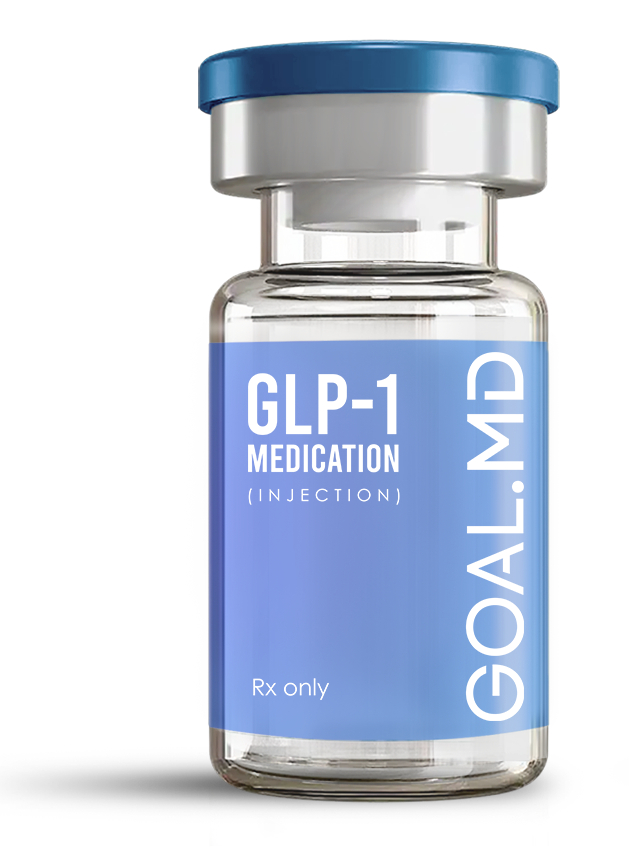
GOAL.MD Health & Wellness Blog
Evidence-based insights, medical weight loss information, and practical tips from our physicians and healthcare experts.

Why GLP-1 Weight Loss Looks Different for Men vs Women
It’s Not Just You—Biology Plays a Bigger Role Than You Think
Suppose you’ve ever noticed that someone of the opposite sex on the same GLP-1 dose seems to be losing weight faster—or slower—than you, it’s not your imagination. And it’s definitely not about “trying harder.”
GLP-1-induced weight loss often appears differently in men and women due to their bodies functioning at a biological level. From hormones to metabolism to fat distribution, the starting point isn’t the same—and neither is the journey.
👉 At Goal.md, patients learn that weight loss isn’t a race. It’s a reflection of your unique hormonal and metabolic blueprint—and your progress is valid exactly as it is.

Why Men Often Lose Faster on GLP-1s
1. Higher Muscle Mass = Higher Metabolic Burn
Men typically carry more lean muscle, which naturally burns more calories—even at rest. So when GLP-1s reduce appetite, their metabolism still has a stronger baseline engine.
This doesn’t mean women are working less—it just means the “starting machine” is built differently.
2. Fat Is Stored Differently
Men carry more visceral fat (around the organs), which responds quickly to treatment.
Women carry more subcutaneous fat (hips, thighs, stomach), which is softer but more stubborn.
Both types reduce GLP-1s—but at different speeds.
3. More Stable Hormones
Men don’t experience monthly hormonal shifts that impact appetite, water retention, and digestion.
Women do—every single month. That alone can make the scale move more slowly or unpredictably.
Why Women’s Results Often Look More “Up and Down”
1. Hormones Shift Throughout the Month
Estrogen and progesterone changes affect:
Water retention
Hunger levels
Bloating
Stress response
Fat storage
This is why many women see faster losses during some weeks and no loss during others—even with perfect consistency.
2. Lower Baseline Muscle Mass
Less muscle means fewer calories burned at rest.
This is exactly why strength training can be a major advantage for womenon GLP-1s.
👉 At Goal.md, women discover how even small muscle-preserving habits make real, measurable differences.
3. Stress Hits Differently
Because of hormonal sensitivity, women tend to feel the effects of cortisol (stress hormone) more intensely.
High stress can lead to bloating, water retention, cravings, or slower loss—even when their routine hasn’t changed at all.
4. Women Often Lose Slower—But More Steadily in the Long Run
While men may lose faster early on, women frequently show stronger long-term consistency once their body finds their rhythm.
Slow, steady loss often leads to better maintenance—and GLP-1s support this beautifully.
Men vs Women: What the Scale Doesn’t Show
Regardless of gender, both men and women on GLP-1s often see meaningful changes that the scale doesn’t capture, like:
A smaller waist
Better insulin sensitivity
More stable energy
Less bloating
Fewer cravings
Improved appetite control
The scale is only one piece of the story—not the whole book.
How to Work With Your Body—Not Against It
For Women
Expect normal fluctuations around your cycle
Add protein + strength training to keep metabolism strong
Prioritize sleep and stress management to control cortisol
Hydrate + electrolytes to balance energy and reduce bloating
For Men
Avoid depending on early rapid losses—pace yourself
Focus on maintaining muscle (appetite may drop too low)
Include more fiber to prevent constipation
Watch sodium, which can cause water retention
👉 Goal.md helps both men and women personalize their GLP-1 routines so progress feels sustainable for their body—not someone else’s.
Final Thoughts
GLP-1 weight loss isn’t one-size-fits-all—because people aren’t one-size-fits-all.
Men and women lose weight differently, respond to stress differently, and carry fat differently. But both paths are real. Both are valid. Both are successful.
Whether your results feel fast, slow, or somewhere in between, you’re still moving forward. Your body isn’t failing—it’s responding exactly the way it’s designed to.
And that deserves patience, compassion, and celebration.
✅ Medically Reviewed by Dr. Michael Fitch, MD
Last Reviewed: October 24, 2025
This article haD physician protocols. Individual results and recommendations may vary. Always consult a licensed clinician before beginning any medical pros been medically reviewed for accuracy and consistency with current clinical practice guidelines. All treatment descriptions reflect real GOAL.MD gram.

Dr. Michael Fitch, MD
Physician, GOAL.MD – Board-Certified in Internal Medicine
Dr. Fitch has treated thousands of patients using evidence-based medical weight-management therapies including GLP-1 and longevity-focused medications. He leads GOAL.MD’s national physician network and personally oversees treatment protocols for weight loss, metabolic health, and nutrition optimization.
👉 Click here and get started with Goal.md
The GOAL.MD blog is published by GOAL.MD, a medical practice dedicated to personalized, patient-centered weight management and metabolic health. Our mission is to make evidence-based care accessible through licensed providers and modern telemedicine services, empowering individuals to reach their health goals safely and sustainably. Any general health information shared on our blog, website, or social channels is provided for educational and informational purposes only. It should not be considered medical advice, diagnosis, or treatment. The content is not a substitute for consultation with a qualified healthcare professional who can provide individualized recommendations based on your specific medical history and needs. GOAL.MD and its affiliated providers make no representations or warranties and expressly disclaim all liability for any loss, injury, or damage resulting from reliance on the information provided herein. If you have questions about your health or a medical condition, please consult with a licensed medical professional before making changes to your medication, treatment plan, or lifestyle.
Why GOAL.MD?
✅ Sourced from audited 503a US compounding pharmacies.
✅ Custom dosages adjusted to your needs.
✅ Free consultation + 24/7 support.

How It Works
1. Quiz
90 seconds. No commitment.
2. Consult
Video chat with your GOAL.MD doctor.
3. Deliver
Meds at your door tomorrow.
Transform Your Life with Physician-Directed Care
Join thousands who've found success with physician-directed care. Take our 3-minute quiz to see if medical weight loss is right for you.







